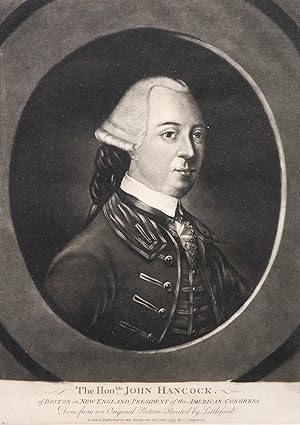Hancock, John; Pseudonym (1 results)
Product Type
- All Product Types
- Books
- Magazines & Periodicals
- Comics
- Sheet Music
- Art, Prints & Posters (1)
- Photographs
- Maps
-
Manuscripts &
Paper Collectibles
Condition
- All Conditions
- New
- Used
Binding
- All Bindings
- Hardcover
- Softcover
Collectible Attributes
- First Edition
- Signed
- Dust Jacket
- Seller-Supplied Images
- Not Printed On Demand
Seller Location
Seller Rating
-
The Honble. John Hancock. of Boston in New-England; president of the American Congress. Done from an original picture painted by Littleford
Published by 'C. Shepherd', London, 1775
Seller: Donald A. Heald Rare Books (ABAA), New York, NY, U.S.A.
Art / Print / Poster
Mezzotint engraving, 14 x 10 inches, superb impression with full margins. Framed (1 1/2" gold leaf Federal frame with ribbed panel and acanthus lead corners, archival Antique white mat and UV Plexiglas). A striking and very rare mezzotint portrait of John Hancock as president of the Continental Congress. This portrait was already highly valued in 1904, when S.V. Henkels described the Hampton L. Carson copy of this print as being 'Of extreme rarity, in beautiful condition with wide margin. The only copy I ever saw'. Henkels' assessment was borne out by the eventual hammer price of $120.00 - a huge price when compared to a number of the other prints of John Hancock in the same sale which fetched under $1.00. (See S.V. Henkels and Davis & Harvey. Catalogue No. 906 Part III Unique Collection of Engraved Portraits [The Hampton L. Carson Collection]. Philadelphia: [1904], lot number 3189). The American patriot is depicted in the rectangular image within an oval frame, wearing a formal wig with ribbon, a high collar, vest, and top coat, the tones of the print are deep and rich, and the features clearly defined. This mezzotint was issued in England as the full reality of the conflict with the American colonies was becoming clear. London publishers, using the names C. Shepherd, Thomas Hart, and John Morris, issued a series of mezzotints of the officers of the American Revolution. This mezzotint of John Hancock was probably done by R. Purcell, who worked under the pseudonym C. Corbutt. Peter Thomas, in his volume, The American Revolution in the series The English Satirical Print, 1600-1832, writes, "The possibility of a compromise solution to the war had been embarrassing for those opponents of government who adopted a civil war interpretation of the conflict.This was founded on the belief or assertion that the King's government posed a sinister threat to liberty in all his dominions.The rebels across the Atlantic were therefore the first line of defence of British liberty, and a series of prints throughout the war depicted as heroes American leaders like George Washington and John Hancock [including the present print]." Thomas reproduces what at first glance is the same engraving from the British Museum collection, but a closer examination reveals that the image of Hancock shows some marked differences to the present example, which is most likely an earlier state. Thomas identifies the artist as "Charles Corbutt" [i.e. R. Purcell], noting that the name, "Littleford," in the caption may be fictitious. Cresswell, in The American Revolution in drawings and prints, also discusses this engraving, but notes (?incorrectly) that the portrait was "after a painting done by Copley in 1770-72." W.C. Andrews Essay on the Portraiture of the American Revolutionary War (New York: 1896) pp.89-90; Cresswell The American Revolution in Drawings and Prints 102; George Catalogue of Political and Personal Satires . in the British Museum V. 5293; S.V. Henkels and Davis & Harvey. Catalogue No. 906 Part III Unique Collection of Engraved Portraits [The Hampton L. Carson Collection]. Philadelphia: [1904], lot number 3189; Russell English Mezzotint Portraits (Engraver not ascertained, Class III) 5; Chaloner Smith British Mezzotinto Portraits (Engraver not ascertained, Class III) 5; P. Thomas The American Revolution 44.


